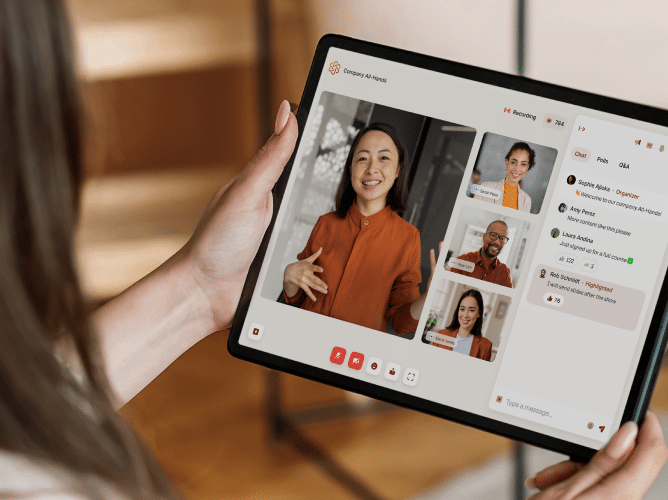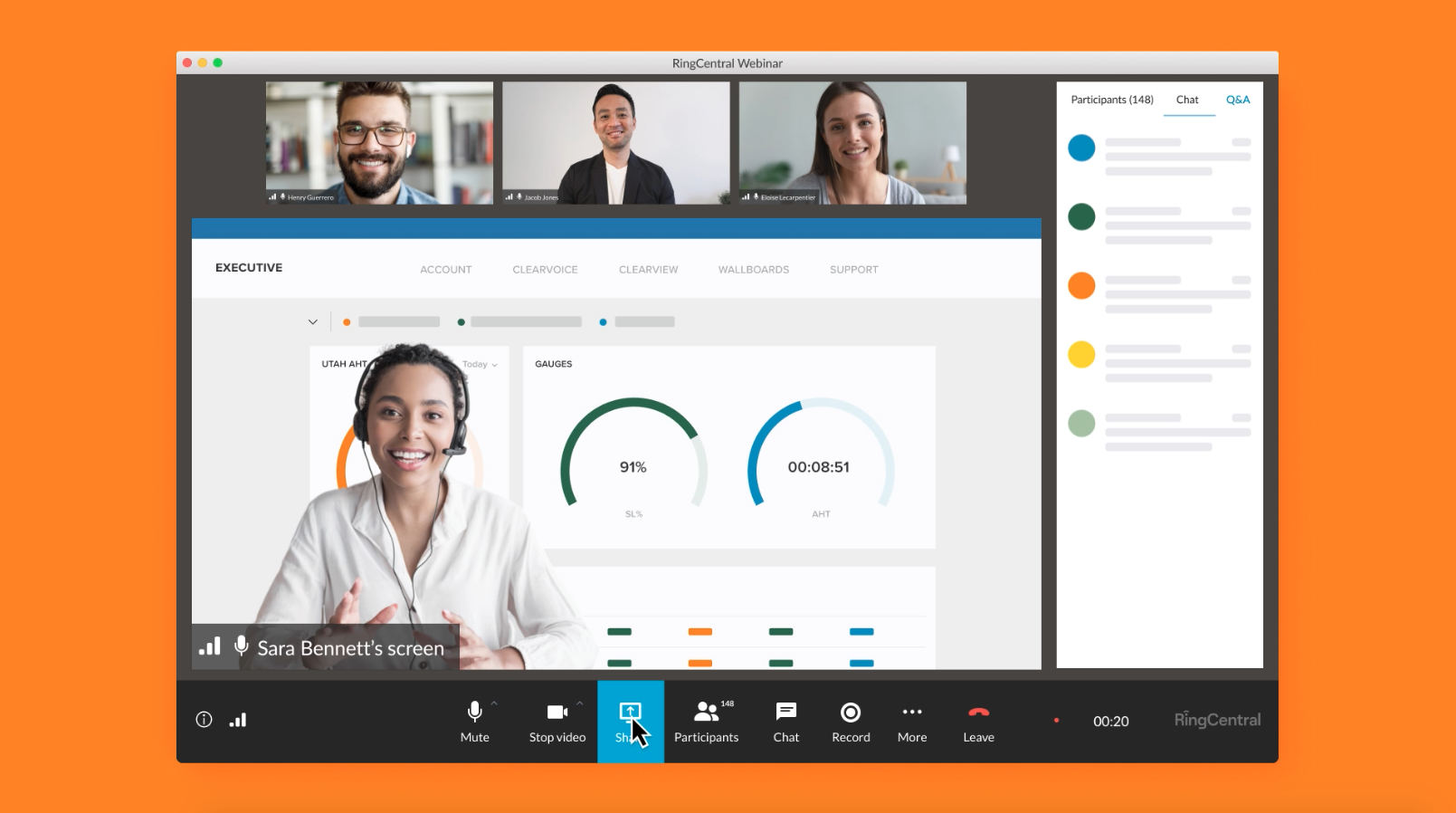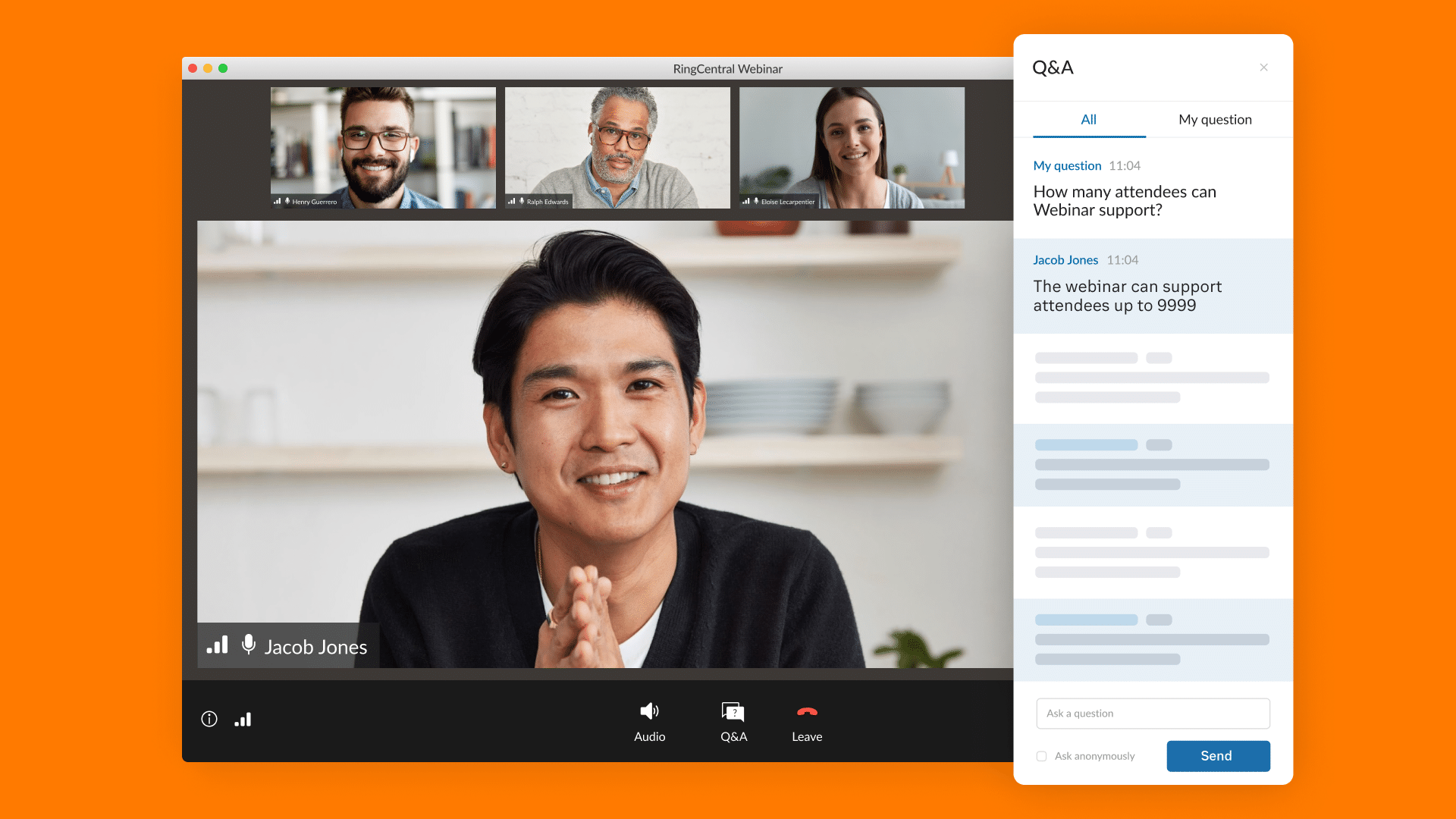“All hands on deck!”
Even if you’ve never been part of a ship crew, you know what that call to action means: Everybody get on deck and pitch in.
Inspired by this concept of getting the full team on board and making sure the ship continues sailing in the right direction, an all-hands meeting brings everyone together to rally around goals and values –– and right the ship if needed. Also called town hall meetings, all-hands meetings are designed to gather your entire team to:
- Share announcements, information, and updates
- Ask and answer questions
- Address wins and challenges
- Hear from the leadership team
Many companies have embraced the all-hands meeting and added it to a regular rotation. Often held on a weekly, monthly, or quarterly cadence, all-hands meetings help employees feel connected, up-to-date, and motivated, all while serving as an opportunity to reinforce company culture.
Whether you’re the CEO or part of the internal events team, you need attendees to walk (or click) into the experience excited and emerge informed, energized, and motivated.
So, how do you build and lead that type of engaging all-hands meeting? With careful planning. Read on to gather best practices –– straight from a team who crafts an all-hands experience their colleagues actually look forward to every week.
In this guide:
5 convincing reasons to host a recurring all-hands meeting
Setting yourself up for success
Creating an all-hands your employees actually look forward to
Partner with a team who knows how to host an effective all-hands
5 convincing reasons to host a recurring all-hands meeting
While your finance team’s monthly budget review and the sales team’s weekly market review might be crucial for success, it’s your company all-hands meeting that can’t drop off the calendar.
After all, the content applies to everyone.
Your team is working to achieve big business goals and fulfill the company mission, so being consistently up to date makes a difference.
But it’s not just the opportunity to stay in the know that makes an all-hands valuable. Here are five reasons to keep those all-hands meetings going –– or to start hosting them if you haven’t already.
1. They provide transparency.
This is where trust is fostered. No one wants to feel like they’re being left in the dark. An all-hands meeting is the perfect opportunity to be open and honest with your team.
2. They keep everyone on the same page.
The bigger a company gets, the harder it can be to feel like you’re all rowing in the same direction. Teams that are disjointed or siloed may end up doubling up on work, creating inefficiencies, or inadvertently letting important tasks fall through the cracks.
An all-hands meeting is a great way to update everyone on initiatives and project statuses so there’s wide-reaching alignment on who’s doing what (and why).
3. They foster company culture.
McKinsey identifies company culture as a competitive advantage that can help a business sustain its growth. Having a visible and open leadership team that invests in regular town halls shows a commitment to communication, accountability, and strengthening company culture.
You can even structure all-hands meetings around company values. For instance, engagement app Polly hosts all-hands meetings twice a month. They have a recurring “values in action” agenda item where they shout out teammates who embody their values.
4. They offer an opportunity to celebrate people and their successes.
Doesn’t it feel good when people notice your hard work? Celebrating wins and shouting out the individuals who made them possible is incredibly motivating and keeps team members excited to continue working toward their goals.
On a related note, being open and honest about projects that weren’t successful can help support a growth mindset-oriented environment, rally people around learnings, and inspire potential improvements.
5. They inspire your team and make people feel closer.
At the end of the day, all-hands are all about keeping your team engaged and inspired.
What better way to do that than gathering the team on a regular basis to unite around common goals, culture, and wins?
When done well, all-hands meetings can help inspire your employees to do the best work of their careers.
Setting yourself up for success
No matter what your reasoning is for hosting an all-hands, you have some prep work to do if you’re going to nail the basics of a successful experience.
Make it a priority and make it consistent
Set your all-hands in stone as early as you can. As new folks join the company, make sure they have this meeting on their calendars, understand its purpose, and know it’s mandatory.
Making it clear this meeting is a priority helps it become ingrained in your company culture.
In terms of cadence, consider your company’s size and pace.
- Weekly is often best for teams who need to stay in lock step on a business that’s moving quickly. It can also be suitable for rapidly growing scale-ups.
- Monthly typically works well for larger companies with more established processes and procedures
- Some teams host town halls on a quarterly basis, which is another option to consider.
Choose your format
Depending on the size and location of your team, the format of your all-hands may vary:
In person: Best for teams in one central, physical location. These are usually structured with the leadership team up front, presenting off a screen with visual aids.
- Virtual: With more companies than ever going fully remote, virtual all-hands use video conferencing tools to connect team members, regardless of their location. With the right platform, you can seamlessly share videos and slides, and have folks from around the world participate and present.
- Hybrid: Workforces split between remote and in-person locations might want to consider a hybrid all-hands meeting.
Decide how long your meeting will be
Most all-hands meetings run for 60 minutes. Having a full hour typically leaves enough time for a team to go through updates and follow up on any questions.
Of course, the frequency and size of the team will impact the ideal length. A team that meets each week might want to go with a 30-minute time slot. Assess the volume and type of content you’ll offer and determine ideal length based on what needs to be on the agenda.
Establish a repeatable structure
You want your employees to know what to expect. Ask yourself a few questions to figure out what lineup works best for your all-hands:
- Who will host the meeting each time? Will it be someone from the events team? Your CEO? Will you have guest hosts? Your emcees set the tone, make sure the agenda progresses according to plan, and call on fellow presenters and participants, so they need to have charisma and know the content.
- How will you set your agenda? Agendas can be organized by department, company values, theme, timeliness, or engagement type (like icebreakers, Q&A, and updates). Assess what will work best for your team.
Once you’ve established the foundation for your all-hands meeting (and maybe done some testing and iterating), you can start to think about how you’ll shape these meetings so they become a true bright spot for your team.
Creating an all-hands your employees actually look forward to
“It makes me feel motivated to react, gets me (re)energized, and provides much-needed cohesion and solidarity.”
“The level of honesty and openness is unprecedented. I’ve never felt more valued and respected.”
“It’s crazy that as a [U.S.] West Coaster, I actually look forward to 7 a.m. every. single. Friday.”
Those aren’t people talking about a TED talk, spin class, or religious experience.
They’re talking about Hopin’s weekly all-hands meeting.
Hopin’s Internal Communication and Events Team – has been producing a company-wide all-hands every week practically since the company began. Along the way, they’ve developed a series of best practices that have turned these meetings into can’t-miss experiences for employees.
Take the fact that a recent internal survey among people at Hopin showed:
- 94% think a company all-hands meeting should be fun
- 92% look forward to joining the company all-hands
- 89% feel more connected after participating in the company all-hands
- 90% feel more informed after the company all-hands
Now, the Internal Communication and Events Team is dishing out their hard-earned all-hands lessons. Learn how to take your town halls to the next level.
Have someone own the responsibility
Preparing for a large-scale all-hands meeting can feel a lot like managing an external event as it often requires multiple people and a long lead time for proper preparation and coordination.
Ideally you have a dedicated manager –– or team, if possible –– who takes ownership of building the experience.
“Have someone own content curation and someone else own event logistics,” says Brian Wilson, senior internal event manager at Hopin. “It’s much easier to share the load.”
Those owning the event should typically be people who know the business and understand experiential marketing as any internal event can contribute to or diminish employee engagement. And you want the experience to be valuable and engaging so it does the former rather than the latter.
Get your presentation template in order
If this is your inaugural all-hands meeting, you’ll need to prepare a central slide deck.
“Work with leaders in your organization to curate content that will have the biggest impact on your audience,” Brian says.
Consider including:
- Standardized slides: Distribute a template deck to anyone presenting with instructions on how to fill it out.
- An agenda: The agenda will change each time, but establish a predictable format so attendees aren’t disoriented. For example, maybe your CEO will address the audience at the beginning of each all-hands meeting.
- Stand-out branding: This sets the experience apart and delivers emotional impact. If you use a virtual platform, you can brand your registration page and the event itself, tapping into company colors and other visual cues.
- An event theme: Large internal meetings are all themed to get people excited. Think Under The Sea, Or Intergalactic.
- Visual and audio elements: Graphics, data visualization, GIFs, images, videos, and music all level up the event content and can make certain concepts easier to digest. Of course you might want to take a different approach depending on the information you’re delivering — remember to match the meeting tone to the situation at hand.
When it comes to content creation, lean on your event platform to make your life easier.
Make sure your speakers understand the process
Presenting at an all-hands can be nerve wracking. Help speakers stay calm by making sure they’re as prepared as possible.
Start by sending all participants the deck with clear instructions on how to join the meeting, how long they’ll speak for, who will be managing their slides, and how they’ll get queued up to join (whether that’s on stage in real life or on a virtual stage).
“Prep your presenters synchronously and async,” Brian says. “Create an async communication channel to share the show order and relevant documents, meet with presenters to ensure they’re comfortable with your event tech, and run through their content so you don’t have any surprises during the meeting.”
Check your tech
Whether your all-hands is virtual, hybrid or in person, your technology is one of the most important elements.
For a physical event, check:
- Microphones
- Video feeds
- Computers that are controlling slides
- Other A/V equipment
- Your internet connection if you’ll be relying on it for any content
For a virtual experience, check:
- Your event management platform’s registration and backstage functions
- Your slides
- Speakers’ audio and video
- Your internet connection and other streaming functionality
- Your communication technology, like Slack or in-platform chats
Have a dress rehearsal
Remember: Practice makes perfect.
If you’ve never put on an all-hands, it’s worth running through the entire event, start to finish, in a rehearsal. This will get your executives and speakers comfortable with their roles.
The last thing you want your first all-hands to do is run over time or feel disjointed and messy, so invest in stress-testing your run of show.
Be sure to set up a time early enough so that everyone’s schedules can align. Once there, run through each segment to have everyone familiar with the agenda, all while testing the presentations.
Send reminders to attendees
Beyond having a mandatory meeting hold, send attendees a reminder email an hour before the event with the location of the meeting or a link to join, if applicable.
Don’t forget to remind them the content they’ll be viewing is confidential.
“Our all-hands are mandatory, but we also encourage people to prioritize coming by putting an emphasis on making them interactive and including fun elements,” Brian says. “We try to infuse humor and make each show as visually appealing as possible.”
Keep the energy high and have fun when appropriate
Your all-hands is a time for your entire organization to get together and it’s your opportunity to reinforce your company culture, so treat it like you’re producing a TV show.
Imagine everyone being excited to tune into the same show every week. What are you doing to keep them engaged?
Try:
- Selecting personable presenters: They’ll set the tone for your meeting, so make sure they’re ready to dazzle.
- Adding fun motifs and jokes: Brian is a standing host for Hopin’s weekly all-hands. He’s known for showing up in a different, conversation-provoking shirt each week. It’s something small that gets the chat buzzing.
- Encouraging participation: We know that engagement is both passive and active — so focus on ways to deliver on both. Bigger meetings can mean less attendee involvement, but if your event content is on point, you can layer in prompts that encourage interactivity.
Above all, keep your entire approach centered around the goals of the meeting.
“One of our goals for internal events is culture building,” says Camilla Boyer, Hopin’s senior manager of internal communications and events. “So it’s a chance to really build that sense of community. It gives people a chance to just have fun together and celebrate our values. The other goal is information sharing and making sure that we are giving people the information they need to do their jobs well.”
Celebrate your values
Your all-hands meetings are a chance to let your company values shine.
“Whenever I see our new joiners attend their first all-hands, they always say, ‘This is how I know Hopin is the place for me,’” Nina says. “It’s a moment where you have so much engagement and such a sense of belonging. It’s a really fun part of our culture. You see people let their hair down, you see execs being a little more funny. It’s a special moment for us to share.”
Those values shouldn’t just impact the tone of your event — they can also directly shape your agenda.
For instance, Hopin has regular segments within the all-hands agenda that showcase company values, like “lead with empathy.” Lead with empathy segments often touch on ways that employees put themselves in their customers’ shoes when thinking about features and priorities.
Shout outs are also included to help everyone feel closer.
“We’ll give employees a StreamYard backstage link spontaneously — it’s really easy to do — so they can give a shout out live to the whole company about a teammate or a group of people they’ve worked with, and have that moment of celebration,” Camilla says. “I’ve seen people moved to tears by the work they’ve done and having that shared with the company.”
Record the meeting for those who couldn’t attend
Vacations, global schedules, sick days –– there are many reasons why some team members may miss your all-hands meeting.
Make everyone feel included by providing a video recording. You can even host watch parties for employees in different time zones who can’t join live so they still feel like they get that community experience. Encourage hosts to address folks who might be watching the meeting at a later time instead of sticking to single region-references.
The bank of recorded meetings will also be a great knowledge hub for stakeholders, including new hires who want to catch up on company history.
When evaluating virtual platforms, look for one that has features that make it easy to record event content.
Ask for feedback
This is a meeting that’s intended to serve and positively impact every member of your team. So, don’t miss out on opportunities to ask them directly what they think of your all-hands.
Soliciting feedback gives employees the chance to:
- Help shape company culture
- Feel heard
- Suggest potentially valuable meeting improvements
Partner with a team who knows how to host an effective all-hands
Whether or not your crew is fully connected and up to speed on vital information can make or break their ability to achieve positive business outcomes. Hosting a regular all-hands meeting is one way to help everyone stay in lockstep.
If you want to learn how to produce your own all hands meeting –– contact a member of our team today.
Originally published Sep 01, 2022, updated Oct 20, 2024





